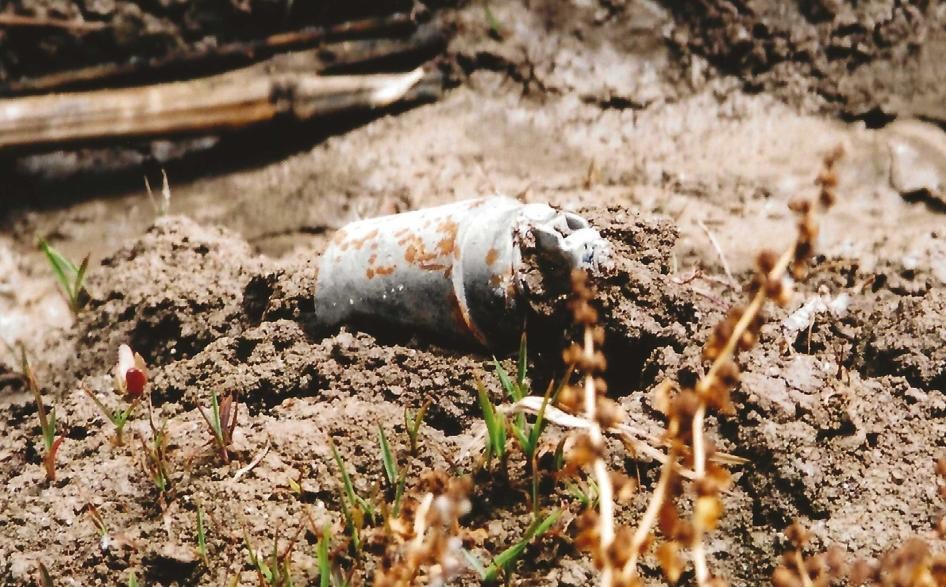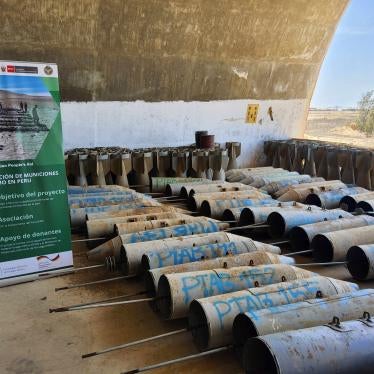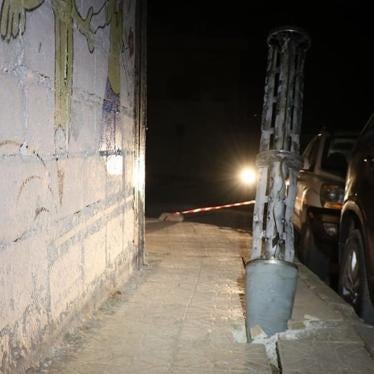The decision announced March 12 by the United States government to transfer additional cluster munitions to Ukraine runs contrary to the norms of the international treaty prohibiting these weapons. The decision came against a broader backdrop of delays by the US Congress in approving military assistance to Ukraine, Ukraine’s shortage of artillery projectiles, and escalating attacks by Russian forces across Ukraine.
Regardless of where one stands on providing military support to Ukraine, the transfer of obsolete US stocks of cluster munitions raises serious humanitarian concerns. It also ignores the lessons of history as past US use of cluster munitions in Afghanistan, Iraq, Laos, and other countries has caused considerable civilian harm and continues to inflict human suffering to this day.
Cluster munitions have been banned by 124 countries, but not by Ukraine, Russia, or the United States. These inherently indiscriminate weapons pose a foreseeable and long-lasting danger to civilians. Delivered by artillery, rockets, missiles, and aircraft, cluster munitions open in mid-air to disperse multiple submunitions over an area the size of several football fields. Many submunitions fail to explode on impact, leaving duds that can wound and kill like landmines for years, until they are located and destroyed.
Despite this known history of harm, the US Department of Defense announced that it would transfer another round of 155mm cluster munition artillery projectiles to Ukraine. The move follows three previous US cluster munition transfers to the country since last July, which have been met with criticism by more than two dozen countries, US lawmakers, and civil society groups.
It’s been over five decades since the US dropped cluster bombs on Laos, the most bombed country in the world per capita. The contamination from cluster munition remnants and other unexploded ordnance is so vast that fewer than 10 percent of affected areas have been cleared. An estimated 80 million submunitions still pose a danger, especially to curious children.
Cluster munitions have caused considerable civilian harm since the very beginning of Russia’s full-scale invasion of Ukraine in February 2022. Russia’s armed forces have repeatedly used cluster munitions, causing hundreds of civilian deaths and injuries. A Human Rights Watch investigation into a single Russian attack on a train station in Kramatorsk on April 8, 2022 found that a ballistic missile carrying a cluster munition warhead killed at least 58 civilians and injured 100 others.
The Ukrainian armed forces have also used cluster munitions to defend against Russia’s ongoing invasion, resulting in civilian harm. A United Nations report and a Human Rights Watch investigation found that Ukrainian forces used cluster munitions in and around Izium city in the Kharkivska region during 2022, when the city was controlled by Russian forces.
Ukraine denied this reported use of cluster munitions, but by early 2023, Ukrainian officials started to publicly ask to be supplied with cluster munitions for use in the fighting. The US responded by transferring cluster munitions delivered by 155mm artillery projectiles to Ukraine in July and September.
In October, the US transferred cluster munitions to Ukraine that are delivered by ballistic missiles (Army Tactical Missile Systems or ATACMS) with a 100-mile range. Each missile contains 950 M74 antipersonnel/anti-materiel submunitions. The US last used ATACMS containing M74 submunitions in 2003 in Iraq. At the time, Human Rights Watch reported that unexploded M74 submunitions “littered farmland.”
The United States stockpiles 155mm M864 artillery projectiles (each containing 72 dual-purpose improved conventional munition (DPICM) submunitions) and M483A1 projectiles (each containing 88 DPICM submunitions). The M42 and M46 DPICM submunitions, which are the size of a D-cell battery, kill and maim indiscriminately.
Any short-term advantages to using cluster munitions are far outweighed by devastating and long-term humanitarian consequences. In objecting to the US cluster munition transfers, the foreign minister of Laos warned that these “heinous weapons” continue to pose “serious threats to the lives and livelihood of our people” decades after the conflict.
According to the Cluster Munition Monitor, in 2022 children accounted for 71 percent of all casualties from cluster munition remnants, where the age was recorded. DPICM submunitions are particularly attractive to children because they resemble a small bell with a loop of nylon ribbon at the end.
The Biden administration has not responded to calls from civil society groups to provide details on the specific types, quantities, and dud rates of the cluster munitions transferred or on the transit points and anticipated end date for the transfers. President Joe Biden has sidestepped US arms export rules in place since 2008 that until now prevented the US from exporting cluster munitions that “after arming do not result in more than one percent unexploded ordnance across the range of intended operational environments.”
On July 7, 2023, Biden signed a presidential “determination” allowing the Pentagon to provide Ukraine with an unspecified quantity of US cluster munitions with a failure rate exceeding 1 percent. US Department of Defense officials claim the DPICM submunitions “have a dud rate less than 2.35 percent” but say that the testing data behind this number is “classified.”
Transparency matters for accountability purposes and for democracy. In practical terms, clearance operators need this information to better understand the scale and extent of threat from explosive remnants, especially unexploded submunitions. The cluster munitions that the United States is sending to Ukraine are more than 20 years old, scatter over a wide area, and have a notoriously high dud rate, leaving a costly and deadly legacy of contamination.
The M42 and M46 DPICM submunitions fail at a rate of at least 14 percent, while the M74 submunitions delivered by ballistic missile (ATACMS) are understood to have a failure rate of 5 to 10 percent, if not higher. Environmental factors in parts of Ukraine such as dense vegetation, high winds, and soil density, and delivery factors such as high wind will most likely contribute to producing an even higher operational dud rate.
Previous recipients of US cluster munitions had to agree that the munitions “will only be used against clearly defined military targets and will not be used where civilians are known to be present or in areas normally inhabited by civilians.”
This time, the US says it has a “classified” agreement in place with Ukraine regarding how the cluster munitions will be used. According to a senior US defense official, “the Ukrainian government has offered us assurances in writing on the responsible use of [cluster munitions], including that they will not use the rounds in civilian-populated urban environments and that they will record where they use these rounds, which will simplify later demining efforts.” The assurances follow five “key principles” for Ukrainian use of cluster munitions that Ukraine’s then-Defense Minister Oleksii Reznikov outlined on X (formerly Twitter) last July.
The ongoing transfers and use of cluster munitions raise concerns for states parties to the 2008 Convention on Cluster Munitions. In September, they collectively “condemned any use of cluster munitions by any actor” and expressed “grave concern at the significant increase in civilian casualties and the humanitarian impact resulting from the repeated and well documented use of cluster munitions” particularly in respect to “the use of cluster munitions in Ukraine.”
The US did not participate in negotiating the Convention on Cluster Munitions, but key allies did, and the convention’s states parties include 24 of the 32 NATO member states. The convention explicitly requires its states parties not to assist with any activities banned by the convention, a strict standard that has impacted non-signatories such as the US.
After the convention was adopted in Dublin on May 30, 2008, the US had appeared to be gradually moving away from cluster munitions as it developed alternative weapons and means of fighting in wars. While the US says it sees military utility in cluster munitions, it has not used them since its 2003 invasion of Iraq, with the exception of a single attack in Yemen in 2009. The US last produced cluster munitions in 2016.
Yet the United States still possesses a stockpile of cluster munitions, which it is now drawing on to supply Ukraine. The US transfers stand in stark contrast to the actions of countries that have prohibited cluster munitions.
Indeed, the transfers have been met with a resolute determination from states parties to show their continued support for the convention. Last September, Bulgaria, Slovakia, and South Africa formally announced the completion of the destruction of their stockpiled cluster munitions. In December, Peru, the last state party with stockpiles of cluster munitions, completely destroyed them, a major milestone for the convention.
Governments pushing to rebuild Ukraine already face a high cost to clear and destroy landmines and unexploded ordnance including cluster munition remnants used by Russia. Use of such weapons by Ukraine and the US cluster munition transfers will only increase this cost.
As the US Cluster Munition Coalition recommends, President Biden should immediately halt the transfer of cluster munitions given the significant humanitarian, human rights, and political risks involved. The US should take steps to accede to the Convention on Cluster Munitions without delay.
Sera Koulabdara is the executive director of Legacies of War and the chair of the US Cluster Munition Coalition starting in 2023. Mary Wareham is deputy director of the Human Rights Watch Arms Division and founding coordinator of the Landmine and Cluster Munition Monitor research initiative.









